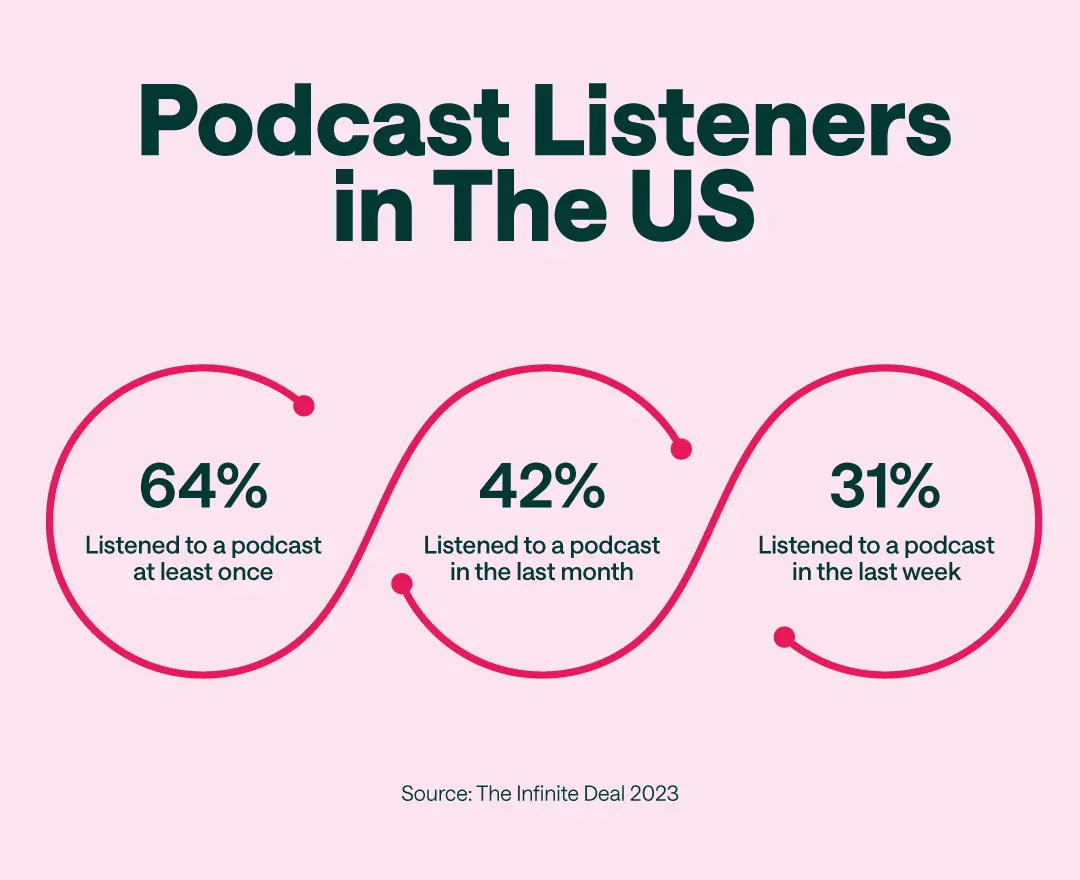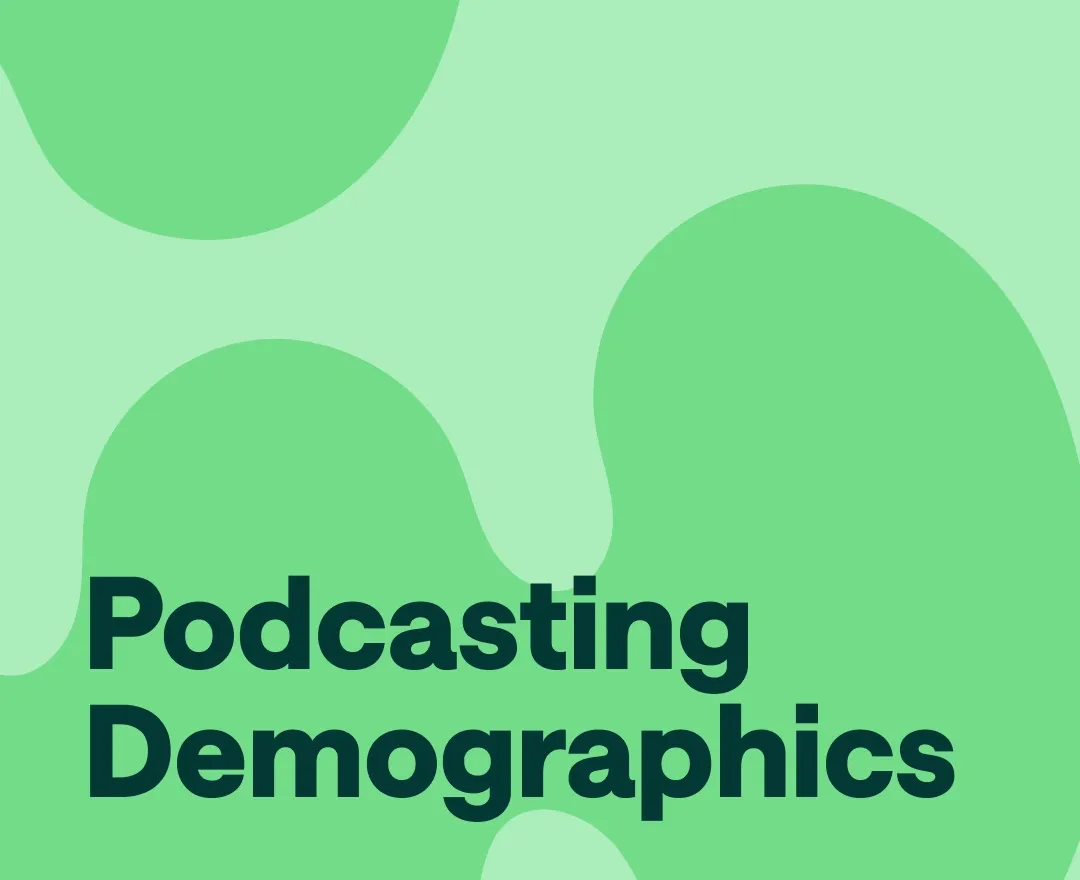Podcasting consumption shows no signs of slowing down. According to the Edison Research Infinite Dial 2023 annual report, over 64% of Americans have listened to a podcast at least once. That's a lot of potential listeners! Moreover, from this group, approximately 42% have listened to a podcast last month.
Now there is one core question that is yet to be answered: who listens to podcasts?
To help you answer this question we have covered the progressive changes in podcasting demographics over recent years in this blog post. So keep reading to be informed and stay up-to-date with the latest changes!
Why Statistics Matters
Whether you're a new or experienced podcaster, understanding your audience is crucial. The more podcasters know about their listeners, the better they can tailor content and strategies to meet their needs. Additionally, having insights into podcasting demographics helps businesses assess whether this medium aligns with their marketing goals.
Before you start a podcast, it is crucial you understand the key trends as they will be your competitive advantage later on. Overall, being up-to-date increases the chances of your show being successful.
Who Listens to Podcasts?

Returning to Edison Research's report, it's interesting to note that the 42% of respondents (estimated 120 million Americans) who have listened to a podcast last month, are fairly evenly distributed across all age groups. The number of podcast listeners in the 12-34 age bracket is slightly higher than the one of 35-54, but not by much. However, it does seem that people over 55 are not that interested in podcasts, with the number of older listeners being 41.18% lower compared to other age groups.
To sum up, for marketers and podcasters, it's crucial to note that while podcasts enjoy widespread appeal among ages 12-54, there's a notable decline in interest from those aged 55 and above.
So if your audience is 55 and older, think about tailoring strategies to connect better with this group.
Podcast Listening Locations
Interestingly, 38% of adult podcast listeners who have driven a car recently have listened to podcasts while driving. This marks a slight increase compared to the 32% registered last year. It's worth noting that podcasts hold the third spot as one of the most popular audio choices in cars, just after AM/FM radio and personal digital media.
Many enjoy listening to podcasts while commuting or packing for their next trip. Overall, podcasts are a great way to make use of time that would otherwise be wasted.
Podcast Listeners by Gender
The Infinite Dial study shows an even split between men and women who listen to podcasts, with a slightly higher proportion of male listeners.
In 2022, 41% of men and 36% of women in the US population listened to a podcast in the last month. In 2023, the numbers increased to 46% of men and 39% of women, indicating a rise in monthly podcast listenership for both genders over the one-year period.
This even gender split is good news for businesses and podcasters alike. It means there is no need to produce different content for each gender. Instead, the focus can be on creating high-quality, engaging content that will appeal equally to male and female listeners.
Podcast Listeners by Country
Buzzsprout data reveals a significant concentration of podcast listeners in the United States, where a substantial 49.6% of the global audience resides. Following closely are the United Kingdom and Canada, contributing 6.0% and 4.5%, respectively.
Here are the top 10 countries in the world that listen to podcasts the most:
- United States - 49.6%
- United Kingdom - 6.0%
- Canada - 4.5%
- Australia - 4.1%
- Taiwan - 3.5%
- Germany - 2.5%
- Netherlands - 2.4%
- Vietnam - 1.9%
- Mexico - 1.7%
- Spain - 1.3%
Looking at these numbers, it's clear that the United States is a major player in the podcast world, influencing almost half of all global podcast listeners. Other English-speaking countries like the United Kingdom, Canada, Australia, and even the Netherlands also play a big role, showing that people who speak English really enjoy podcasts.
It's interesting to note that Taiwan is in the top five, highlighting that podcasts are popular worldwide, not just in English-speaking countries. As podcasts keep gaining popularity, these details can help those creating content and the platforms they use to make sure they're reaching a diverse international audience.
Changes in Podcasting Demographics
Podcasting has come a long way since its inception in 2004 as an audible revolution. In the early days it was a niche medium, with only around 6 million people tuning in.
However, over the past few years podcasting has exploded in popularity. In 2023, approximately 183 million people tuned in to podcasts, with an estimated 120 million having listened to them just last month.
Podcasting demographics have changed significantly since 2004. The medium is no longer the reserve of early adopters and tech-savvy millennials. Instead, it's a mainstream activity enjoyed by people of all ages, genders, and ethnicities.
The Secrets Behind Listener Behavior Revealed
To determine who listens to podcasts the most, it's crucial to understand listener behavior.
First things first. What is listener behavior? Simply put, it's the way people interact with audio content. This can include everything from how often they listen to particular episodes to how likely they are to share the show with their friends.
Understanding listener behavior can help podcasters create icebreakers because it can give them insights into their audience's preferences. Moreover, a number of factors related to listener behavior influence how creators market their shows online.
To determine who listens to podcasts the most, it's essential to delve into listener behavior.
Firstly, what exactly is listener behavior? In simple terms, it’s about the way individuals engage with audio content. This encompasses various aspects, ranging from the frequency of listening to specific episodes to the likelihood of sharing the show with friends.
Understanding listener behavior provides valuable insights for podcasters in crafting engaging content, including effective icebreakers, tailored to their audience's preferences. Moreover, a number of factors related to listener behavior influence how creators market their shows online.
#1 How often do listeners tune in?
This is perhaps the most important question when it comes to listener behavior. The answer determines how often podcasters should release new episodes and how they should promote each show.
Unfortunately, there is no straightforward answer to this. The reality is that people's listening habits vary widely, and there is no one-size-fits-all solution.
There are people who listen to podcasts religiously, tuning in as soon as a new episode is released. Others prefer to binge-listen, catching up on a show's back catalog in one go. Others dip in and out of podcasts, only listening to the episodes that interest them.
The best way to determine how often your listeners tune in is to ask them directly. This can be done through a survey or by simply sending out a tweet or email asking for feedback.
Another way to get an idea of listening habits is to look at the data. Most podcast hosting service providers offer analytics with insights into how people interact with your show.
#2 What time of day do listeners tune in?
The time of day people listen to podcasts can have a lesser impact on listener behavior than frequency. After all, if you're releasing new episodes at midnight, you're not going to reach as many people as you would if you release them at midday.
Again, there is no definitive answer to this question. Conducting a survey or asking for quick feedback via social media platforms can help creators find the ideal episode upload time.
Who Listens to Podcasts the Most in 2023?
Advisers are always keen to know who their target audience is. In 2023, podcast listenership was notably prominent among the age group of 12-54, showcasing a widespread appeal that spans various generations. However, there is a decline in interest among those aged 55 and above, indicating that tailoring strategies for this demographic might be crucial.
Geographically, the United States leads as the podcast powerhouse, influencing nearly half of the global audience. English-speaking countries such as the United Kingdom, Canada, Australia, and the Netherlands also contribute significantly.
With an even split between male and female listeners, businesses and podcasters can focus on creating content that appeals equally to both genders. The global nature of podcast consumption is evident in the inclusion of Taiwan among the top five countries with substantial podcast listenership. Overall, the podcasting demographic has evolved into a mainstream activity enjoyed by people of all ages, genders, and ethnicities.








